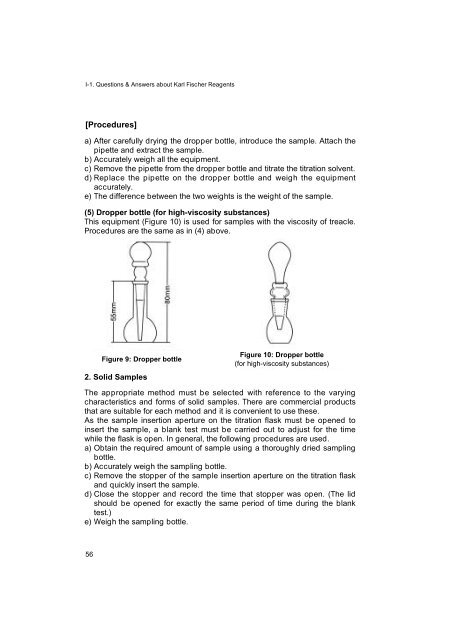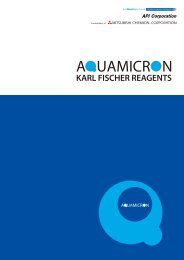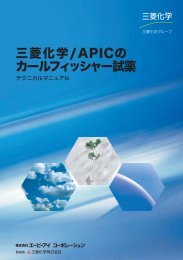Development of Karl Fischer Reagents
Development of Karl Fischer Reagents
Development of Karl Fischer Reagents
You also want an ePaper? Increase the reach of your titles
YUMPU automatically turns print PDFs into web optimized ePapers that Google loves.
I-1. Questions & Answers about <strong>Karl</strong> <strong>Fischer</strong> <strong>Reagents</strong><br />
[Procedures]<br />
a) After carefully drying the dropper bottle, introduce the sample. Attach the<br />
pipette and extract the sample.<br />
b) Accurately weigh all the equipment.<br />
c) Remove the pipette from the dropper bottle and titrate the titration solvent.<br />
d) Replace the pipette on the dropper bottle and weigh the equipment<br />
accurately.<br />
e) The difference between the two weights is the weight <strong>of</strong> the sample.<br />
(5) Dropper bottle (for high-viscosity substances)<br />
This equipment (Figure 10) is used for samples with the viscosity <strong>of</strong> treacle.<br />
Procedures are the same as in (4) above.<br />
2. Solid Samples<br />
The appropriate method must be selected with reference to the varying<br />
characteristics and forms <strong>of</strong> solid samples. There are commercial products<br />
that are suitable for each method and it is convenient to use these.<br />
As the sample insertion aperture on the titration flask must be opened to<br />
insert the sample, a blank test must be carried out to adjust for the time<br />
while the flask is open. In general, the following procedures are used.<br />
a) Obtain the required amount <strong>of</strong> sample using a thoroughly dried sampling<br />
bottle.<br />
b) Accurately weigh the sampling bottle.<br />
c) Remove the stopper <strong>of</strong> the sample insertion aperture on the titration flask<br />
and quickly insert the sample.<br />
d) Close the stopper and record the time that stopper was open. (The lid<br />
should be opened for exactly the same period <strong>of</strong> time during the blank<br />
test.)<br />
e) Weigh the sampling bottle.<br />
56<br />
Figure 9: Dropper bottle<br />
Figure 10: Dropper bottle<br />
(for high-viscosity substances)




